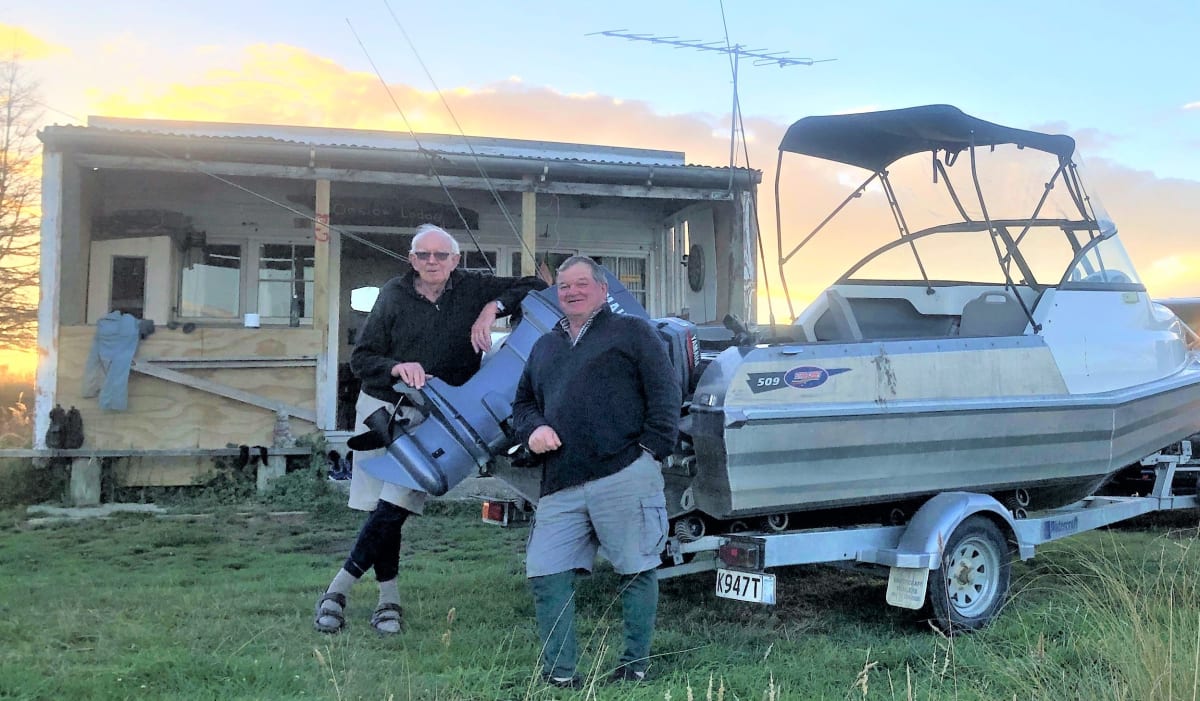
It has been described as a “game changer” that would see fossil fuels disappear from our electricity generation. Lake Onslow in Central Otago is proposed to be NZ's Battery - but little is known about the place itself. Jill Herron reports.
Lake Onslow is man-made and started life as the delightfully-named ‘Dismal Swamp’. Bleak, windswept and utterly beautiful, it lies like a giant puddle in a depression high in the north-west Lammerlaw Ranges, near Roxburgh.
It’s an empty-feeling place, mostly made up of sky. Aside from a tiny breeze whispering through the tussock, the valley was quiet the day Newsroom visited the lake. The only sounds were distant honking geese and occasional growl of a boat motor, briefly propelling fishermen across the water to a prime spot, before falling silent again.
The lake is a unique and cherished brown trout fishery, set in a series of real-life Grahame Sydney paintings.
While remote, Lake Onslow is not particularly hard to find. Crossing the Clutha/ Mata-Au River from SH8 at Millers Flat, it’s about a 40-minute climb past lifestyle blocks and farms on winding gravel. The road is fairly rough up top - bare schist rock in parts and some boggy patches: A road suitable for 4WDs or early model Holden Commodores piloted by seasoned southerners.
The route actually winds on past the lake and if you kept going for another 80km you would end up in Ranfurly, over in the Maniototo.
At the lake, the annual cicada hatch was in full swing and the abundant brown trout – typically smallish but feisty - were biting like crazy.
Four of the dozen or so huts were occupied and, with a flurry of day-trippers arriving, the boat ramp was briefly backed-up. With 800ha (8sqkm) of lake to explore, however, any water traffic soon seemed to disperse and fade away into the haze.
The huts all sit on private farmland and always have done. There’s no public reserve, just legal access to the fishery via the road, which also serves the surrounding high country sheep and beef stations. There’s also the marginal strip around most of the lake edge to accommodate boats pulling up or shore-based anglers.
There is no cellphone coverage or electricity. At night it’s a star-gazer's paradise, with zero light pollution, excellent clarity and a vast expanse of sky.
Over the past century, Onslow has been dammed for mining, irrigation and local power generation via the high-gradient Teviot River.

Fishermen who Newsroom spoke to were puzzled by the idea that that the Government would contemplate a massive-scale development so far from where the power is needed.
This distance-to-market issue is only one of a range of tricky factors associated with the project, which have prompted the government to invest heavily in its feasibility study.
The Onslow scheme, while the most prominent, is being looked at alongside other options for smaller pumped hydro in the North Island, as well as biomass, biogas and biofuels, geothermal energy, hydrogen, compressed or liquid air and flow batteries.
The basic idea is that when power prices are low, water would be pumped 600m uphill from the Clutha River to an enlarged lake, via a 24 km tunnel inside the mountain. The lake, expanded to 74sqkm, would lie behind a 60m-high dam and the powerhouse would also be located underground.
Onslow would still be under half the size of Lake Pukaki, but its capacity would be about 1000 megawatts – bigger than the country’s biggest power station, coal-and-gas-fired Huntly, at 953MW. The lake would hold an incredible 5500 gigawatt-hours of storage. That’s bigger than the nominal full storage of the country’s entire hydro-electric lakes, which is 4409GWh.
Hydrologist and University of Waikato associate professor Earl Bardsley, who first saw that potential in Lake Onslow, highlights the scheme’s civil engineering scale.
“If constructed, Onslow pumped storage would be the largest hydro project in New Zealand's history - equivalent to the Manapouri Power Scheme and the Benmore Dam rolled into one.”
He doesn’t believe smaller potential North Island sites would add up to enough storage to carry the country through its dry-year shortage problem and points out that each would require a separate consenting process.
Bardsley believes Onslow is ideally placed in the South Island to moderate electricity output derived from the South Island hydro lakes in both wet and dry years.
“There is no increase in transmission loss because Onslow will just store South Island electrons for a time before they head north.”
The transformative nature of such a project for New Zealand’s energy scene was great.
“It would enable the green transition to a low emissions electrified economy, away from the risk of dry years. In that context, Onslow pumped storage would be by far the greatest national impact concept ever to emerge from a New Zealand university”.
As to the ecology, Bardsley says a special reserve could be created near Onslow to protect precious wetlands and an endangered Teviot flathead galaxias fish that lives in one of the lake’s five tributaries.
A Fishery Like no Other
As a fishery, Lake Onslow is incredibly valued, says Otago Fish & Game Council environmental officer Nigel Paragreen.
“The lake is quite special in terms of flora, fauna and setting. It’s a high country tussock-lined lake, which gives it a special feel. There are a few like it in Otago, but none as productive in terms of sports fish. The lake has a great amount of spawning habitat in the surrounding creeks and there are an abundance of trout, so much so that it has a 10-bag limit and is the only lake in NZ to do so.”
He says the fishery ranks highly with users due to the excellent catch rate, excitement of the annual cicada hatch and unique mountain-top setting.

“The surrounding tussock creates an interesting phenomenon in the cicada hatch. Between January and February each year, when the conditions are right, cicadas hatch and such a large number end up on the water surface that the trout enter a feeding frenzy. This makes the fishing experience quite exciting and lots of people head up to the lake.”
Many of the visitors have been trekking up to Onslow after brown trout for decades. It’s a Teviot Angling Club tradition and camping up at the club’s humble wooden hut, grandly named the Teviot Lodge, is a cherished experience for many.

Paragreen says it’s early days but sentiment shows, unsurprisingly, that people are wary of losing something special.
“Generally, the comments I’ve heard from anglers is that they’d like to retain the fishery. We don’t yet have the final information to tell us how the fishery and fishing experience will be affected, however, it is clear to me that it’s highly valued and worthy of consideration.”
First findings due in May
The first stage of the Government’s $30m feasibility study is well underway, with initial findings due within months. In 2020, Labour announced an extra $70m was being set aside to expedite stage two, with an eye on the prize of making the country’s electricity generation 100 percent renewable by 2030, five years earlier than planned.
There are predictions of a four-year build, with 3000 direct jobs but where the workers would live is unknown as Central Otago grapples with its long-term job surplus and associated housing shortage. Whether the locals have an appetite for another think-big scale project after the construction of the Roxburgh hydro dam(1956) and Clyde dam(1993) is another unknown.
Teviot Valley Community Board chairman Raymond Gunn says people are adopting a ‘wait and see’ approach but many still recall the upheavals of the previous project and how it changed the valley forever. Gunn is also on MBIE’s technical advisory group for the NZ Battery Project to provide the Government with a local perspective.

Housing and infrastructure are on the list of topics included in stage one of the feasibility study which will be presented to ministers in May. Potential design options will also be outlined, as well as cost updates and environmental, cultural and other impacts.
Some geotechnical investigation has begun but the more detailed work set down for stage two of the study will provide a more accurate assessment of the overall feasibility.
“It is our expectation at this stage that this work [stage two] will go ahead, subject to agreement from landowners and other relevant approvals,” an MBIE spokesperson said.
Access agreements with landowners for this, more detailed, geotechnical work are still in progress.
Proof that the project would lower wholesale electricity prices is not necessary for Onslow to proceed, MBIE confirmed. That is, however, on the list of criteria, alongside practicality, size, employment, emissions reduction, maximising renewable electricity and feasibility.
There’s no doubt the energy gains could be great but a monumental amount of dirt will need to be shifted and in terms of scale, the project will make the existing dam at Onslow look like something the kids made in the sandpit at lunchtime.
By the end of this year, a clearer picture is expected to emerge, including details of the full environmental impact of the build. Decisions that follow will at least give farmers, lake-users and the wider Teviot community, whose lives will be hugely impacted, some certainty.

* Made with the support of the Public Interest Journalism Fund *








